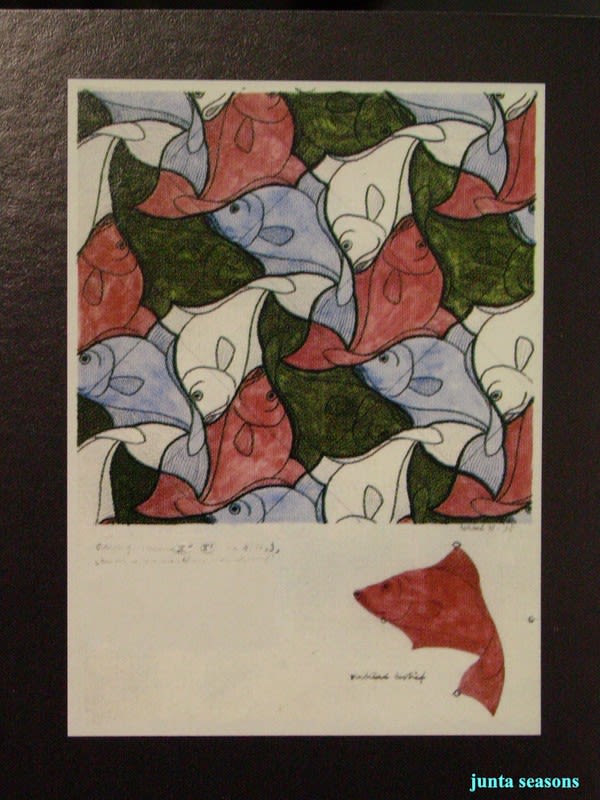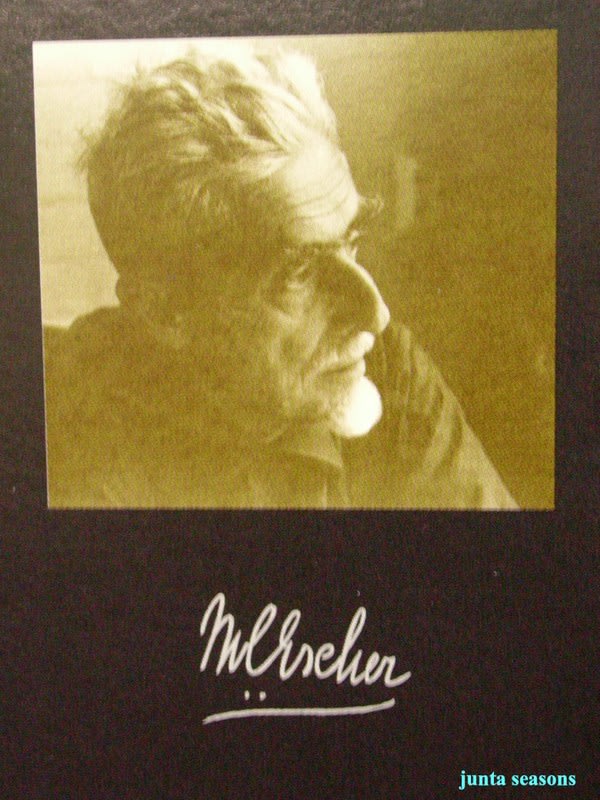先日
スーパーエッシャー展
に行きました。
あはは
おもろいなあ
とゆてましたら
さる方から
こんなんどない
とうれしいクリスマスプレゼント。
エッシャーの魚で覆われた球のレプリカです。
EUのエッシャー協会から取り寄せて頂いたそうで
ありがたや
ありがたや。

直径7cmの球面は3尾の魚の組み合わせで覆われます
Sphere with fish Beech wood, 1940
A systematic division of the plane, based on a triple rotation.
Escher was fascinated by Japanese woodcarving, which he admired greatly, and during the war years he transposed a number of motifs on to wooden spheres. As the sphere has no limitation, this shape was perfect for his 'infinitive' systems.
The sphere with fish was his first one in relief and his personal favorite.

平面は4尾の魚の組み合わせ

これがエッシャー大先生
Maurits Cornelis Escher (1898-1972)
Escher initially pursued a career in architecture, but his passion for graphic arts soon changed his mind. He was tayght the principles of graphic art by S. Jesseurun de Mesquit in the Dutch town of Haarlem. He then started traveling, somewhat restlessly, throughout Southern Europe where he made sketches and studies of the landscape.
After 1936, his realistic style and subject matter changed profoundly, when he drew the first of his famous 'impossible realities'. Fascinated by the majolica tiling in the Alhambra, he became obsessed by the ideas that form the basis of the regular division of the plane, such as the crystallographic principles of sifting, glide-reflection and rotation.
In his studies he reflected on his personal amazement and admiration forthe patterns of which the space surrounding is formed. 'The one who is amazed, should realize it is a miracle'.
During the rest of his life, Escher devoted himself to graphicart and the incorporation of transcendental ideas, such as metamorphosis and infinity, within the world of mathematics.
スーパーエッシャー展
に行きました。
あはは
おもろいなあ
とゆてましたら
さる方から
こんなんどない
とうれしいクリスマスプレゼント。
エッシャーの魚で覆われた球のレプリカです。
EUのエッシャー協会から取り寄せて頂いたそうで
ありがたや
ありがたや。

直径7cmの球面は3尾の魚の組み合わせで覆われます
Sphere with fish Beech wood, 1940
A systematic division of the plane, based on a triple rotation.
Escher was fascinated by Japanese woodcarving, which he admired greatly, and during the war years he transposed a number of motifs on to wooden spheres. As the sphere has no limitation, this shape was perfect for his 'infinitive' systems.
The sphere with fish was his first one in relief and his personal favorite.

平面は4尾の魚の組み合わせ

これがエッシャー大先生
Maurits Cornelis Escher (1898-1972)
Escher initially pursued a career in architecture, but his passion for graphic arts soon changed his mind. He was tayght the principles of graphic art by S. Jesseurun de Mesquit in the Dutch town of Haarlem. He then started traveling, somewhat restlessly, throughout Southern Europe where he made sketches and studies of the landscape.
After 1936, his realistic style and subject matter changed profoundly, when he drew the first of his famous 'impossible realities'. Fascinated by the majolica tiling in the Alhambra, he became obsessed by the ideas that form the basis of the regular division of the plane, such as the crystallographic principles of sifting, glide-reflection and rotation.
In his studies he reflected on his personal amazement and admiration forthe patterns of which the space surrounding is formed. 'The one who is amazed, should realize it is a miracle'.
During the rest of his life, Escher devoted himself to graphicart and the incorporation of transcendental ideas, such as metamorphosis and infinity, within the world of mathematics.










